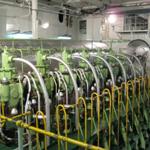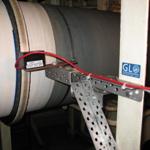Reducing Fleet-Wide Fuel Consumption
 FLAGSHIP has achieved major advances in accurately measuring on-board power requirements and thereby enabling a reduction in fuel consumption through the FLAGSHIP-EEM (Energy Efficiency Monitoring) project. The developed system allows for the continuous evaluation of power requirements at every stage of a vessel’s voyage, with improved fuel consumption reducing operational costs and the environmental impact.
FLAGSHIP has achieved major advances in accurately measuring on-board power requirements and thereby enabling a reduction in fuel consumption through the FLAGSHIP-EEM (Energy Efficiency Monitoring) project. The developed system allows for the continuous evaluation of power requirements at every stage of a vessel’s voyage, with improved fuel consumption reducing operational costs and the environmental impact.
The FLAGSHIP-EEM project was led by Germanischer Lloyd and was supported, delivered and trialled in conjunction with Reederei NSB in Germany, Marintek and Teekay Shipping in Norway, Danaos Shipping Co Ltd of Greece, Rolls Royce in the UK and Wärtsilä Finland Oy of Finland.
Designed as a tool for ship owners and operators, FLAGSHIP-EEM supports the crew in making more efficient use of energy on board. Due consideration is given to both the main and auxiliary engines ensuring propulsion and electrical economies are evaluated. It provides transparent information about the current energy use and increases awareness for options to improve efficiency. FLAGSHIP-EEM enables comparison of current consumption to baseline consumption and recent history and establishes a database of operational data for evaluation of operational measures and changes in machinery.
Actual Power Consumption
 To date most ships have not been equipped to measure and display actual power consumption and as a result crews tend to run vessels at too high consumption patterns. When the FLAGSHIP-EEM development team started looking into how vessel efficiency could be improved no detailed consumption data was actually available. They had to undertake a detailed analysis of on board power consumption in order to determine efficiency influencing parameters. They also collected operational data over time to ensure that any external influences and variations were considered to ensure modelling accuracy especially in relation to predicting potential fuel savings. Dr. Gerd Würsig, deputy head of department at Germanischer Lloyd Environmental Research and project manager for FLAGSHIP-EEM said: “FLAGSHIP-EEM makes energy monitoring possible without the need to install highly accurate fuel flow meters. It is also unnecessary to access proprietary engine data which manufacturers are generally unwilling to disclose – this is a significant development”.
To date most ships have not been equipped to measure and display actual power consumption and as a result crews tend to run vessels at too high consumption patterns. When the FLAGSHIP-EEM development team started looking into how vessel efficiency could be improved no detailed consumption data was actually available. They had to undertake a detailed analysis of on board power consumption in order to determine efficiency influencing parameters. They also collected operational data over time to ensure that any external influences and variations were considered to ensure modelling accuracy especially in relation to predicting potential fuel savings. Dr. Gerd Würsig, deputy head of department at Germanischer Lloyd Environmental Research and project manager for FLAGSHIP-EEM said: “FLAGSHIP-EEM makes energy monitoring possible without the need to install highly accurate fuel flow meters. It is also unnecessary to access proprietary engine data which manufacturers are generally unwilling to disclose – this is a significant development”.
Onboard Trial
 Malte Freund, project engineer at Germanischer Lloyd commented: “The system has been trialled on board a multi-purpose vessel since May 2010 during which time indications have been positive and a whole range of small, hidden energy saving opportunities have been identified. Offline evaluation of the data indicated significant potential savings could be made by improved machinery operation and more timely repairs. As an example, the data indicated that a saving of some 500 running hours per year could be achieved combined with improved fuel economy, simply by turning off diesel generators that were unnecessary to the ship’s actual power requirements.”
Malte Freund, project engineer at Germanischer Lloyd commented: “The system has been trialled on board a multi-purpose vessel since May 2010 during which time indications have been positive and a whole range of small, hidden energy saving opportunities have been identified. Offline evaluation of the data indicated significant potential savings could be made by improved machinery operation and more timely repairs. As an example, the data indicated that a saving of some 500 running hours per year could be achieved combined with improved fuel economy, simply by turning off diesel generators that were unnecessary to the ship’s actual power requirements.”
Patented
FLAGSHIP-EEM’s monitoring of the air compressors also highlighted higher than expected running time. Further investigation identified leakages in the pressurised air system which, when repaired, would lead to operational savings. Germanischer Lloyd has been sufficiently impressed with performance to have patented the method for energy and fuel consumption evaluation and we have incorporated specific learning from this project into products for launch later this year.”
Mr Herman de Meester, Coordinator of FLAGSHIP commented: “The adoption of specific learning in to new products for the advancement of the industry is exactly what EC projects such as these are all about. FLAGSHIP-EEM delivers environmental and commercial advantages to the maritime transport industry delivering the FLAGSHIP mission. FLAGSHIP-EEM works in parallel with current initiatives such as the IMOs energy efficiency design index (EEDI). EEDI currently addresses new vessels only, while FLAGSHIP-EEM is applicable to both new and existing vessels ensuring that energy efficiency can be optimised in both situations.”
Image courtesy of Germanische Lloyd






